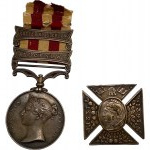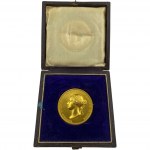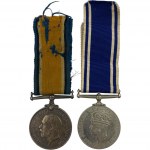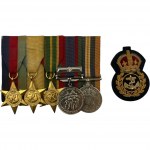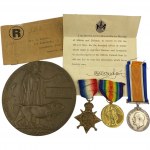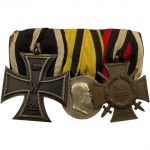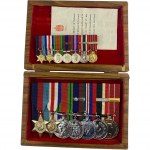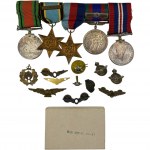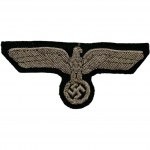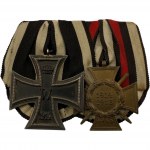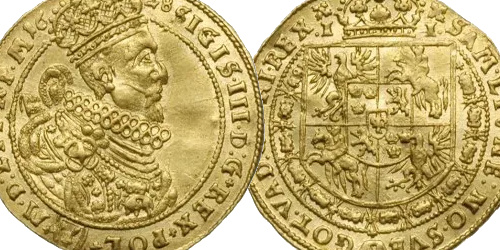India General Service Medal with Afghanistan N.W.F. 1919. Named: 38299 SGT. J. R. SCOTT, S&T.C.
Inidian Police For Distinguished Conduct. Named: J. R. Scott Inspr. of Police. Bombay.
Wazirforce Bitish Hockey Winners 1923-24 Medal. Named: J. R. SCOTT
James Ridsdale Scott was one of the last British officers to head the Bombay (now Mumbai) police during the closing years of the Raj. The surviving documentation is scattered across India-Office, Home Department, and Maharashtra State Archives files, most modern reference works give him only passing mention. The outline below pulls together what can be pieced together from those primary sources, contemporary newspapers such as the Times of India and Bombay Chronicle, and the annual India Office civil lists.
1. Family and early career
• Born 7 December 1891 at Hexham, Northumberland, to the Rev. John Ridsdale Scott, a Church of England clergyman, and Elizabeth (née Cruddas).
• Educated at Durham School and Keble College, Oxford; took a second-class degree in modern history (1913).
• Passed the competitive examination for the Indian Police (IP) in 1914, trained at Met Police College (Hendon) and at the Police Training School, Moradabad.
• Served in the United Provinces (1915-1920) and Central Provinces (1920-1932), moving through the usual ranks (Assistant Superintendent → District Superintendent). Won the King’s Police Medal (KPM) in the 1931 New Year Honours for “courage and tact” during the grain-riots at Jubbulpore.
• Transferred to the Bombay Presidency Police in 1933 as Deputy Inspector-General (CID), where he built a reputation as “that quiet North-countryman who always knows more than he says.”
2. Appointment as Commissioner of Police, Bombay
• Appointed Commissioner on 9 August 1943, replacing N. R. Smith (acting) after Sir Charles Howley’s retirement. The post was the senior policing position for the city and island of Bombay and carried ex-officio membership of the Governor’s Executive Council.
• Rank and honours at the time of appointment: Companion of the Order of the Indian Empire (CIE, 1942 Birthday Honours) and King’s Police & Fire Services Medal (KPFSM).
3. Major episodes during his tenure (1943-1946)
a) Wartime security
• World War II still raged in Asia when he took office. Bombay was the principal embarkation port for Allied troops bound for Burma and the Middle East. Scott had to organise coastal blackouts, enforce Defence of India Regulations, and coordinate with Naval Intelligence on sabotage threats.
b) The Bombay Dock Explosion (14 April 1944)
• The British freighter SS Fort Stikine, loaded with explosives, cotton bales and gold bullion, blew up in Victoria Dock. Nearly 800 people were killed and large sections of the police and fire brigades were wiped out. Scott, who had been in the control room on Marine Drive, directed cordon and rescue operations for 36 straight hours. A formal letter of appreciation from Viceroy Wavell commended “Commissioner Scott’s cool mastery of a scene of unparalleled destruction.”
c) Post-war labour and food unrest
• 1945 saw a rash of strikes by dockworkers and textile-mill hands protesting wage controls and rice shortages. Scott authorised the creation of a 3,000-strong Reserve Strike Police drawn from wartime auxiliary battalions; Marxist and Congress labour leaders accused him of heavy-handedness, but the Governor’s minutes note that violence was “remarkably limited for the scale of provocation.”
d) Royal Indian Navy (RIN) Mutiny (18-23 February 1946)
• When ratings on HMIS Talwar mutinied, the Castle Barracks lay inside Bombay city limits. Scott placed a double ring of armed police and halted tram services to the Fort, while the Admiralty deployed Marines within the dockyard. On 22 February, 300-plus strikers in the city attempted to march to the Gateway of India; the police opened fire at two junctions (Flora Fountain and Princess Street), resulting in 7 deaths and 42 injuries. The incident became one of the last large-scale uses of lethal force by the colonial police in Bombay.
e) Rising communal tension
• Although the great Calcutta killings (Aug 1946) eclipsed Bombay, smaller Hindu-Muslim clashes flared repeatedly in Mohammed Ali Road, Pydhonie and Nagpada. Scott reorganised the city into 70 “peace sectors” with joint Hindu-Muslim citizen patrols—an experiment later cited by the Morarji Desai government in 1950.
4. Relations with nationalist politicians
• Scott met regularly with moderate Congress leaders such as B. G. Kher (Premier of Bombay Presidency) but refused permission for large avenue marches until late 1945. He was viewed far less antagonistically than Calcutta’s Commissioner (Sir Charles Tegart), yet Bal Thackeray’s father, the cartoonist Prabodhankar Thackeray, labelled him “Skarot Saheb” (“Throttler-Sahib”) in a Marmik pamphlet after the RIN shootings.
5. Retirement and later life
• Stepped down on 15 August 1946, handing over to R. W. B. Godfrey (acting; the first Indian commissioner, J. A. L. Pinto, came in 1947).
• Returned to England; served 1947-1952 as Adviser on Overseas Police to the Colonial Office, making inspection tours of Malaya and the Gold Coast.
• Married (1924) Marjorie Kathleen Eustace; one son (Roger) and one daughter (Helen). Lived in Budleigh Salterton, Devon.
• Died 11 April 1974, aged 82. His personal papers (diaries 1939-46, a few photographs of the Dock Explosion) are held privately by the family; copies of two wartime situation reports are in the British Library, IOR: L/P&J/8/664.
6. Where to find primary material
• India Office Records, London: Home Department Proceedings (public order), Police Service Lists, and Governor’s fortnightly intelligence summaries.
• Maharashtra State Archives, Elphinstone College complex, Mumbai: Commissioner of Police Confidential Files, 1943-46 (especially file CP-C/241 on the RIN Mutiny).
• Contemporary newspapers: The Times of India (digitised, ProQuest), Bombay Chronicle, and Marathi dailies like Lokmanya.
• Memoirs: M. C. Chagla’s “Roses in December” and Vice-Admiral S. N. Kohli’s oral history both reference Scott during the mutiny.
Because colonial police officers seldom left autobiographies—and because many service files were destroyed after independence—Scott remains a relatively obscure figure. Yet the archival fragments show him as a capable, if orthodox, Raj policeman who happened to be in command during some of Bombay’s most dramatic 20th-century crises.”


























